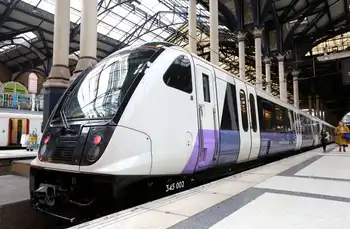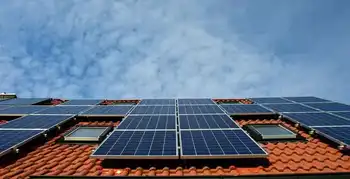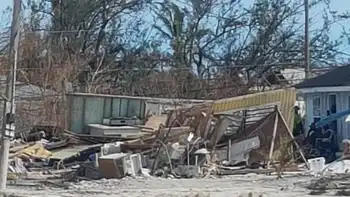Remembering the blackout of 2003
By New York Times
High Voltage Maintenance Training Online
Our customized live online or in‑person group training can be delivered to your staff at your location.

- Live Online
- 12 hours Instructor-led
- Group Training Available
A surge of electricity to western New York and Canada touched off a series of power failures and enforced blackouts yesterday that left parts of at least eight states in the Northeast and the Midwest without electricity. The widespread failures provoked the evacuation of office buildings, stranded thousands of commuters and flooded some hospitals with patients suffering in the stifling heat.
In an instant that one utility official called ''a blink-of-the-eye second'' shortly after 4 p.m., the grid that distributes electricity to the eastern United States became overloaded. As circuit breakers tripped at generating stations from New York to Michigan and into Canada, millions of people were instantly caught up in the largest blackout in American history.
In New York City, power was shut off by officials struggling to head off a wider blackout. Cleveland and Detroit went dark, as did Toronto and sections of New Jersey, Pennsylvania, Connecticut and Massachusetts. In some areas, the power problems were scattered. The lights remained on in Albany and in Buffalo, but not in nearby suburbs.
Officials worked into the night to put the grid back in operation and restore electric service. Mayor Michael R. Bloomberg said that that the power was back on in parts of Brooklyn, the Bronx and Queens by 11 p.m. - but not Manhattan. ''We're certainly not out of the woods yet,'' the mayor said.
He said that New Yorkers should treat today ''like a snow day'' - listen to the radio and ''exercise your common sense.'' Transit officials said there would be no subway service for the rush hour this morning. Mr. Bloomberg said that he expected the subways to be running eventually today, but that traffic lights might be out of sequence.
''It wouldn't be the worst thing to do to take a day off,'' he said.
The blackout began just after the stock exchanges had closed for the day, a slow summer day of relatively light trading, as thousands of workers were about to head home. Office workers who were still at their desks watched their computer monitors blink off without warning on a hot and hazy afternoon. Soon hospitals and government buildings were switching on backup generators to keep essential equipment operating, and the police were evacuating people trapped in elevators.
Airports throughout the affected states suffered serious disruptions, including the three major airports in the New York metropolitan region, but did not close. Still, delays and cancellations rippled all the way to San Francisco. Federal Aviation Administration officials said the airports in the affected states had switched to emergency power. They said that airliners in the air had not been in danger, although many were rerouted to terminals beyond the blackout.
Thousands of subway passengers in New York City had to be evacuated from tunnels, and commuter trains also came to a halt. Gov. George E. Pataki said that 600 trains were stranded.
Officials said that the cause of the blackout was under investigation but that terrorism did not appear to have played a role. Tom Ridge, the homeland security secretary, met with his advisers in Washington. But Mayor Bloomberg said that there had been ''no evidence of any terrorism whatsoever.''
President Bush, who was in San Diego yesterday, said he planned to order a review of ''why the cascade was so significant.'' He also said the electrical grid might need to be modernized.
''It's a serious situation,'' he said.
''I have been working with federal officials to make sure the response to this situation was quick and thorough and I believe it has been,'' he told reporters.
The office of the Canadian prime minister, Jean Chrétien, initially said the power problems were caused by lightning in New York State but later retracted that. Canadian officials later expressed uncertainty about the exact cause but continued to insist the problem began on the United States side of the border. The Nuclear Regulatory Commission said that the seven nuclear plants in New York and New Jersey and two in the Midwest had shut down automatically when the failure occurred.
Telephone service was disrupted, especially calls to and from cellular phones. Most of the problems, telephone company officials said, had to do with heavy use. Officials said the trouble was compounded by power failures at some cellular transmitters. Cash-dispensing teller machines were also knocked out, so people who did not have cash on hand could not buy flashlights, batteries or other supplies.
The power failure exacted a variety of tolls in Michigan and Ohio, tying up the freeways in Detroit, forcing the cancellation of minor league baseball in Toledo, Ohio, and sending Jennifer M. Granholm, the governor of Michigan, into emergency meetings without the use of lights or computers.
In Times Square in New York, billboards instantly went dark and the city was left without traffic lights and the usual sounds of rush hour. Volunteers directed traffic with mixed success. Some stores in Manhattan closed as cashiers fumbled with registers that no longer toted up purchases. The Metropolitan Museum of Art emptied out, but not before some art lovers had pulled flashlights from backpacks and purses and trained them on paintings.
In a city still jittery from the Sept. 11 terror attack, some people worried as they tried to find their way home. ''All I could think was here we go again - it's just like Sept. 11,'' said Catherine Donnelly, who works at the New York Stock Exchange.
Mr. Pataki said he had ordered the National Guard to assist state and local authorities, but New York City officials said the Guard's aid was not necessary.
Police officials in the city said they first responded as if the power failure had been the work of terrorists, and with the concern that the city was suddenly vulnerable. Heavily armored officers were sent to likely targets and emergency command operations were begun in every borough.
The officials said that the city was mostly calm in the first hours of the blackout, and that every precinct in the city had moved to control traffic at critical intersections.
By midnight, though, the police reported several incidents of looting and bottle throwing in Lower Manhatan and Brooklyn.
So there was no air conditioning, no television, no computers. There was Times Square without its neon glow and Broadway marquees without their incandescence - all the shows were canceled. So was the Mets game against the San Francisco Giants at Shea Stadium. And there was a skyline that had never looked quite the way it did last night: the long, long taut strings of the bridges were dark, the red eyes that usually blink at the very top not red, not blinking.
As the lights came back on, officials estimated that 10 percent of the city's households again had power by 10 p.m. About that time, power was also restored in Newark and Buffalo.
''This is a very, very slow deliberate process, and you have to be very careful how you do it, or you will have the whole system fail again,'' said acting superintendent of New York State police, Wayne E. Bennett.
Mr. Bloomberg said the subways had been evacuated safely and that he believed the rescues of people from stuck elevators had gone smoothly. But one woman, after having walked down 18 flights of stairs at a Midtown office building, collapsed and died as passers-by, rescue workers and paramedics tried to save her.
As the afternoon dragged on with no lights and no word on how soon subways and trains might resume service, some hiked home. Others filled bars. A Kentucky Fried Chicken restaurant on East 14th Street near Avenue B gave away ice cream, one scoop to a customer. The Haagen-Dazs shop near Union Square had a ''power outage sale,'' selling cups and cones for $1 apiece.
Drivers, benefiting from suddenly very essential radios, flashed news bulletins to people in the street. ''It's a major grid, and it's out from Toronto to Ohio,'' Sharon Dennis told a throng that had gathered around her green Ford Taurus on West 34th Street shortly before 6 p.m. ''They say they don't know how long it will take to restore power.''
Mr. Pataki declared a state of emergency, and went to the Office of Emergency Management at the state police headquarters in Albany, where he said he would remain until power was restored.
Mr. Pataki reluctantly recalled one of the two major blackouts of the last 40 years in the Northeast - the 1965 power failure, which left an 80,000-square-mile stretch of the United States and Canada without electricity for as much as 27 hours. ''It wasn't supposed to happen again,'' he said, ''and it has happened again. And there have to be some tough questions asked as to why.''
The Nov. 9, 1965 blackout began with an overloaded relay at a hydroelectric plant in Ontario. That plunged Toronto into darkness, then Syracuse, then four of the five boroughs of New York City, which had been drawing 300,000 kilowatts from the Niagara Mohawk utility in upstate New York. The lights stayed on in parts of Brooklyn and on Staten Island, because of a generating station that was not knocked out.
On July 14, 1977, lightning hit two Con Edison transmission lines north of New York City, tripping relays that soon shut down power plants in the New York metropolitan area. Parts of the city were dark for more than 25 hours, and there was widespread looting.
Yesterday, the North American Electric Reliability Council, which was set up by the utility industry after the blackouts of 1965 to reduce the likelihood of cascading failures, said that power problems were felt throughout the entire eastern interconnection, which covers most of the country east of the Mississippi River. The South was unaffected by the blackout, the council said.
The council had issued its annual summer reliability assessment of the supply of electricity earlier in the year, concluding that the nation should have adequate resources to meet the demand for power this summer. But it warned of possible problems, particularly around New York City, if extreme weather produced unusually heavy demand.
Phillip G. Harris, who is in charge of the consortium that oversees power distribution from New Jersey to the District of Columbia, said the exact cause of the blackout would not be known for some time. ''We have to get into the forensics of it,'' he said. There was high demand for electricity yesterday, he said, ''but it was not any hotter than we had last year.''
He said that his system had recorded a ''massive outflow'' of power to northern New York or Canada shortly after 4 p.m. He said that the surge overloaded power lines that took themselves out of service.
For people with medical problems, the blackout added another layer of anxiety. Emergency rooms were flooded with patients with heat and heart ailments. At Harlem Hospital, a spokeswoman said that a number of pedestrians had been hit by cars because traffic lights were out.
At Jamaica Hospital in Queens, where even emergency power was lost for several hours, a spokeswoman said that officials there had been denied permission to divert patients to other hospitals.
In neighborhoods where memories of the 1977 blackout linger, yesterday did not bring the sounds of that long-ago evening. This time, there was little looting, officials said, and the grinding of iron store gates being forced up and the shattering of glass was absent.
In Bushwick, the Brooklyn neighborhood that was at the center of the vandalism in 1977, Mario Hernandez, a 44-year-old air-conditioner mechanic, remembered the looting well.
''I got five couches, five TV's, two stereo sets, gold chains, everything you could think of,'' he said yesterday, recalling that hot evening when he was 18. ''Even the decent people, the churchgoing people, were taking stuff back then.''
Police officers waited in the 83rd Precinct, on Knickerbocker Avenue. ''So far so good,'' an officer said. ''Nothing out of the ordinary. It's actually quieter than normal.''
There was at least one pocket of trouble: On the Lower East Side, an upscale sneaker store was broken into and one of the owners beaten and bloodied by a group of youths between 11 p.m. and midnight. ''These animals are wrecking my store,'' the owner said.











